
Be ready for more than sightseeing: Tokyo Metropolitan Government's disaster preparedness event for foreigners in Japan
- Written by: Lucio Maurizi
While planning your trip to Japan, you’ll probably have a hard time deciding what of the many beautiful locations you’ll want to visit. The country’s sights, architecture, art, and entertainment make it one of the most sought after locations to vacation for visitors from all over the world.
At the same time, Japan is well known also for its powerful and potentially dangerous natural disasters. The Japanese government announced that there's a 70% chance of a 7-class earthquake hitting Tokyo within the next 30 years. A shake that powerful could cause enormous damage and loss of life.
It is not unwarranted for many foreigners to be worried. But should this possibility scare you off when planning your visit to Japan? We say it shouldn't, and, more importantly, so does the Japanese government. The thing is to know what could happen and know what to do in each case.
Preparedness is the key to safety

Tokyo is expecting over 10 million visitors in 2020, for the Olympics and Paralympics, and it's been preparing for long to face an earthquake and to strengthen existing structures and infrastructures.
Furthermore there are a number of emergency transportation systems being implemented, as well as new shelters and emergency units, to accommodate the vast number of people expected to be in Tokyo during the summer of 2020.
A quake could hit at any time, and, depending on where you’re hailing from you may or may not be used to dealing with nature’s most aggressive side. Many of these quakes are small tremors and little more. However it is important to prep for a "what-if" scenario, just in case.
Regardless of when you’re planning to visit, being prepared and knowing what to do, is the key to safety in every situation, however disastrous.
To help foreigners learn what to expect and how to prepare, as well as act, in the eventuality of an earthquake or other natural disasters, the Tokyo Metropolitan Government organized an interesting and useful initiative: a disaster preparedness event aiming at teaching visitors and foreign residents how to deal with any situation, which may present itself.
We attended this event and you’ll be as prepared as you’ll ever need to be, after reading this article. But first, let’s take a look at what potential scenarios could occur in Japan.
Earthquakes in Japan

Those who have never felt an actual earthquake, might be overwhelmed by the experience. Japan is unfortunately infamous for its earthquakes, and chances are that you’ve seen on the news something about the Land of the Rising Sun being hit by some powerful shock.
The reality is that Japan is hit by earthquakes daily. Before you unpack your bags and cancel your tickets, keep in mind that most of these shocks are imperceptible to people. Items in houses won’t even shake and you’ll never know an earthquake just occurred.
This is not to say that powerful earthquakes never hit Japan. From the year 684 until the date of this article, there have been 81 powerful earthquakes that have caused damage and, sometimes, loss of lives. That makes for an average of about one huge earthquake every 16 years.
The good news is that of these disasters, very few took Japan and the Japanese people by surprise. As horrible as these events are, the country and its people have made earthquake preparedness and response into a science.
Buildings are designed to withstand massively powerful earthquakes. Response teams are highly trained and experienced in dealing with any emergency. Shelters are spread across the whole country, in every major city, as well as in all rural areas. We'll dive into that part a little later.
Other meteorological phenomena to know about
While it is easy to mentally link earthquakes and Japan, there are several other phenomena to mind when in Japan.
In the summer of 2018 Japan made the news across the world because of what was possibly the worst summer anybody in the country could remember. A combination of extreme weather and natural disasters hit the country in just a few months.
Again, this is such a rare occurrence that very few people alive could remember something similar happening. What’s more, the response and fixes were swift and effective.
Nonetheless why not learn a little bit about what you might experience during your visit to Japan?

1. Extreme heat
Summer months in Japan can be brutal. Depending on the region you’re visiting, you might have to deal with impossibly high temperatures and humidity.
Make sure you’re always dressed appropriately, stay hydrated, and take frequent breaks in nicely air-conditioned stores, or cafes, while running around from one landmark to the next.
2. Rainy season
Starting around May and ending around July (depending on the region), Japan is hit by the so called tsuyu (or baiyu), the rainy season. Cold air currents from the north collide with warm ones from the south generating an almost permanent rain for a month or so.
In extreme cases, like in the summer of 2018, this can cause floods and landslides.
The rainy season is not only common, but also predictable. It’s been visiting Japan for literally millennia and the infrastructure and buildings in the country are exceedingly impervious to it.
Make sure you do have some heavy rain clothes and a nice umbrella with you, though.
3. Typhoon season
Yes, Japan has a typhoon season as well. Typhoon season is technically from May to October, but not the whole country gets hit every year.
A typhoon is a powerful storm accompanied by high-speed winds and rain. Should you be in Japan while a typhoon occurs, if it’s hitting or about to hit your area, stay indoors, and enjoy some tea, snacks, or a card game with friends. It’ll be over before you know it.
Flights will likely be canceled, and some other preemptive measures might be taken in your area (interruption of trains, or subway; stores closing).
If a typhoon is merely passing by and not hitting your area, for you it will probably translate into a cloudy or rainy, windy day.
Very rarely, like in the summer of 2018, typhoons can be extremely powerful. Once again, stay indoors, protect your windows with shutters or by using duct tape in the shape of a cross on the glass.
In very extreme cases you might be in a situation similar to that of the aftermath of an earthquake.
So why don’t we jump into what’s there to know in case that happens?
The Tokyo Metropolitan Government Disaster Preparedness Event
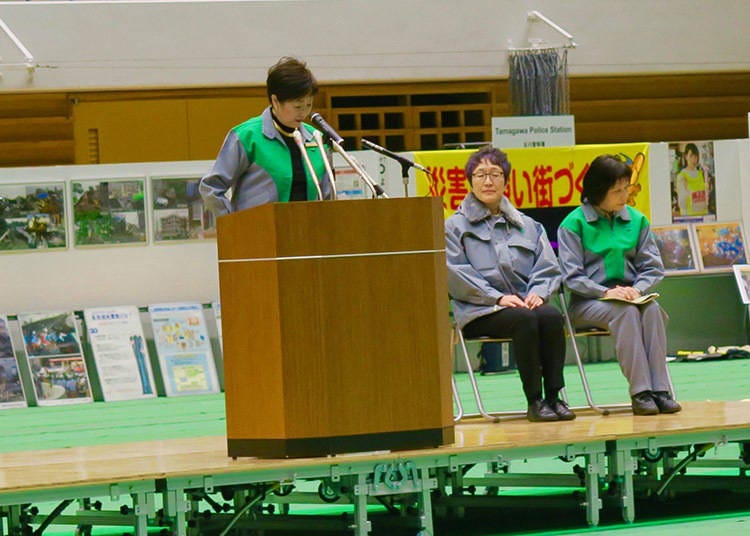
At the event, participants (hundreds of expats from all over the world) were able to experience firsthand a number of scenarios.
Through the use of virtual reality, simulation rooms, and with lessons given by trained professionals, the participants and the audience could learn how to behave and react to fires, earthquakes, and emergency situations, as well as practice CPR.
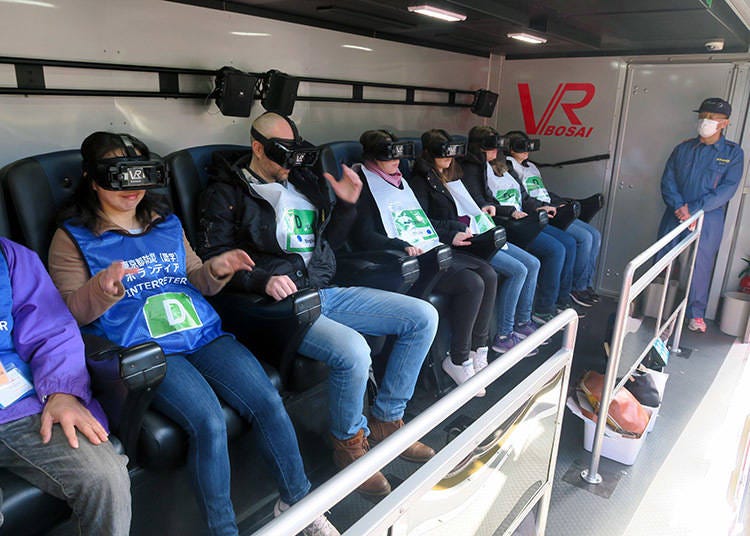
VR earthquake and disaster experience
It’s obviously hard to imagine exactly what might happen during an earthquake, unless one experiences one. At the event, participants, accompanied by interpreters and staff, were able to go through a fully immersive earthquake scenario.
The VR vehicles were equipped with seats and VR goggles. A controlled shake simulated an earthquake while the participants, safely strapped onto their chairs, witnessed a realistically depicted earthquake and its aftermath.
The people we interviewed (one of whom had experienced the large earthquake that hit Osaka on June 18, 2018) found the experience helpful in understanding how to move and what they might see in a real life situation.

Earthquake simulation room
Even with a VR experience under your belt, it can be hard to react quickly and protect yourself, unless you’ve done it a few times already.
Sure, the best case scenario would be to never have to experience an earthquake in your own home, but what would you do if you had to act quickly?
In order to prepare for such an eventuality, participants could step into one of two simulation rooms that would reproduce a powerful earthquake with the purpose of teaching what to do and how to behave if you’re indoors.
The room was equipped with a table, props, and an HD monitor giving more realism to the situation.
Visitors who took part to the drill were visibly surprised by the force of the shake, but they overwhelmingly confirmed that the drill had taught them a lot in just a few minutes.
So what should you do if an earthquakes hits?
Once again, preparation is key. Reacting calmly to a potentially dangerous situation is really hard. That’s why reading science on how to behave and what to do, or participating to drills can be extremely effective in enabling you to judge a situation and act accordingly.

1. Protect yourself
Once you start feeling the shocks, duck under a table, holding onto its legs. It’s important to protect yourself from falling objects or shattered glass.
If a table is not available or out of reach, use mattresses, pillows, quilts or any other structure that could offer protection. If you have nothing to hold onto, lay down away from windows or doors.
Regardless of the room you’re in, always make sure to protect your head.

2. Don’t rush
After the tremors subside, do not rush out of your shelter. Wait to make sure that there are no immediate aftershocks or items or furniture that might still fall.
Make sure you turn off any gas stove you may have had on at the time of the earthquake. Switch off the circuit breakers and the main gas valves.
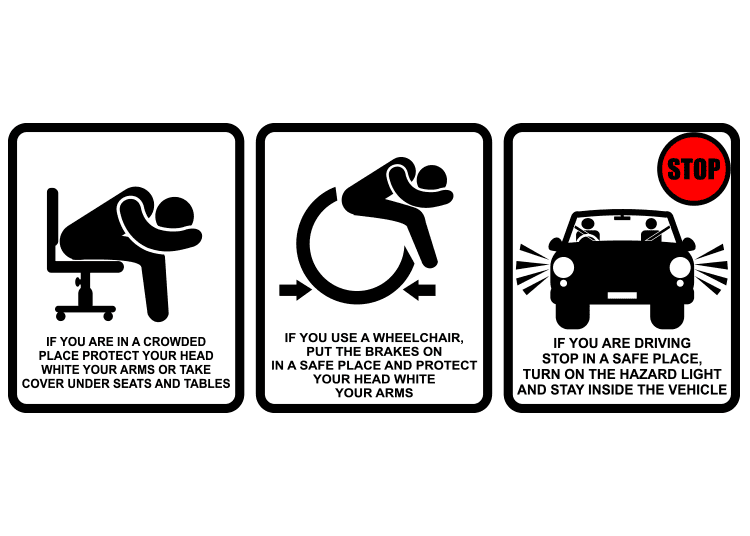
3. Secure a way out
After the shaking subsides, open doors and windows, so to have ways out at any time.
If you’re not sure whether the building you’re in meets the resistance standards, depending on the situation, you might want to head out.
If you’re trapped
If you are trapped under furniture or debris, avoid shouting. As counterintuitive as it may seem, shouting might result in exhaustion and breathing problems. Instead find items that could produce loud noises to hit walls, doors, or floors.
In crowded outdoors areas
Panic is your worst enemy. Stay away from glass and older structures. Immediately seek refuge in large concrete buildings, and act quickly.
Most people in Japan have trained their whole life for such scenarios, but should panic ensue, remain calm and move away from the streets.
First Aid drills
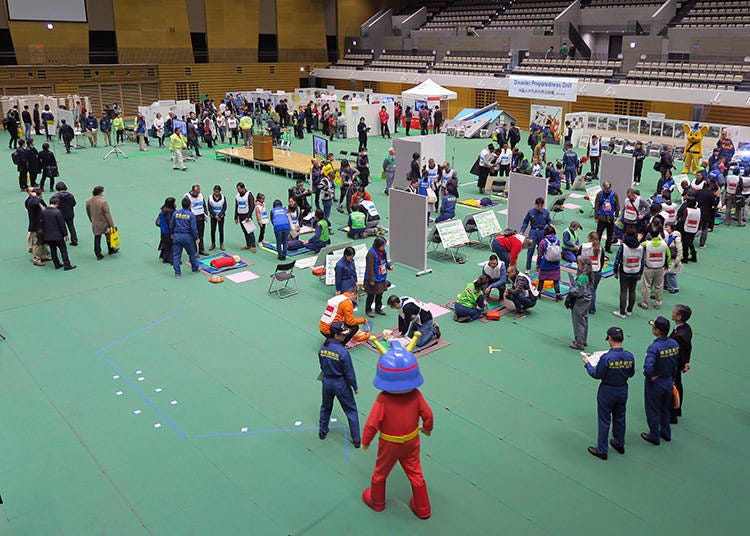
After an earthquake, or a typhoon, or any other disaster, you may find yourself in a situation in which you’ll need to help other people.
Not knowing what to do could cause even more problems. The Tokyo Metropolitan Government gave a huge space to hands-on drills on cardiopulmonary resuscitation (CPR).
Check if the person is conscious
With a loud voice, try to get the person’s attention, move their hands and feet, to see if they respond or if they have suffered injuries.
Don’t do it all by yourself
Ask around for help, make sure someone looks for emergency personnel, and ask around for an automatic external defibrillator (AED).
Intervene if necessary
If you notice that the victim is not breathing, with your hands on the victim’s chest press down (about 5cm) rhythmically for about 100 times per minute. Every 30 chest compressions, breathe air into the victim’s lungs twice. If the victim is bleeding, avoid the breathing, and only apply chest compressions.
In case of fire – evacuation
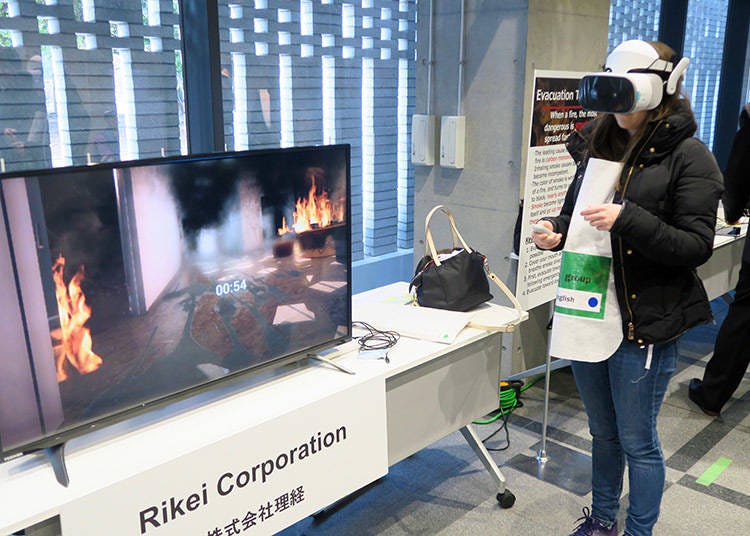
The Tokyo Metropolitan Government event used VR not only for earthquake preparedness, but also for fire evacuation drills.
Participants could be virtually placed into a burning building. In order to navigate through the flames, participants had to physically move in real space, as well as “walk” by using a controller.
The simulation placed the participants into different magnitudes of fires, with several escape routes and potential obstacles to get around of, in order to get to safety.
The experience was realistic and it taught participants what to expect, but also what to look for, in case of fires.
Should you need to evacuate
In some cases entire large areas need to be evacuated to avoid further damage or loss of life. Evacuations have proven to be extremely successful in reducing, in many cases, the loss of life to zero, even in the face of rare and powerful phenomena.
For foreigners visiting Japan the evacuation process can seem daunting. What should you do, who should you follow, can you expect messages in languages other than Japanese?
First of all familiarize yourself with the signs
Language Barrier
Depending on where you are at the time of an evacuation, you may or may not hear instructions in languages other than Japanese.
While emergency responders might not be fluent in English, usually, emergency announcements, especially in major cities (but increasingly so also in more rural areas), are going to be transmitted in Japanese and English, and often in Mandarin Chinese, and Korean.
Should you not hear the instructions in a language you understand though, there are always ways to know where to go, in case of an evacuation.
The signs are going to be your first clue, but in addition, emergency responders will set up multiple indications (in Japanese and English) to follow to a shelter or evacuation route.
Furthermore you’ll see emergency responders indicating the right direction with light sticks.
If you’re stranded, and you have Internet access, utilize the NHK World websites and channels, which will provide information and real time instructions in English.
Alternatively you can also use your phone to make emergency calls and ask to speak with staff in English (and often other languages) (you’ll find a list of all useful numbers and websites at the end of the article.
Finally, even if you don’t feel too comfortable with your Japanese, it might be helpful to learn some useful phrases:
・Where is the evacuation center?
避難所はどこですか? / Hinanjo wa doko desuka?
・I am looking for my family.
家族を探しています。 / Kazoku wo sagashiteimasu.
・What is the name of this place?
ここは、どこですか。/ Koko wa doko desu ka?
・I need information in English.
英語の情報がほしいです。 / Eigo no joho ga hoshii desu.
・When will transportation be back in service?
(電車・バス・空港)はいつ復旧しますか。 / Densha, basu, kuuko) wa itsu fukkyuu
shimasuka?
・Where can I get (food/water/a blanket)?
(食べ物・水・毛布)はどこで手に入りますか?/ Tabemono/mizu/mofu) wa doko de te ni
hairimasuka?
・Where can I make an international call?
国際電話はどこでかけられますか? / Kokusaidenwa wa dokode kakeraremasuka?
Emergency Bags

Japanese authorities recommend all people living in Japan to have emergency bags ready for any eventuality, but what about visitors?
The information available is rather scarce. Is there anything you should and can prepare beforehand that won’t cost you all your available packing space?
Yes! Follow this list and you’ll be all set:
1. Mobile phone charger
2. Whistle
3. Paper map (you can also get one in Japan with emergency routes and shelters mapped out). If you prefer, save a google map to use even offline, or take screenshots.
4. Flashlight
5. Coins (Japan still has a lot of public phones, in case you find yourself in need of one).
6. Picture of the people you’re travelling with, in case you get separated. Make sure you also keep your ID’s and health insurance card handy.
7. Simple first aid kit, if you like to be super prepared.
8. Space blanket.
9. Laminated index card with your name, birth date, blood type, any allergies/health issues/medications you are taking, contact name and phone number, and emergency contact information. (Make sure each of the people in your party has the same.)
10. When you’re in Japan, buy a few instant ramen cups and water bottles, and put them in your backpack with all the other stuff you brought from home.
All these items won’t occupy more than a suitcase pocket worth of space, but will be very helpful.
There’s more that you can prepare, should you feel the need to, but the above items will save you space, and help you in an emergency situation. If you’re interested in a comprehensive list of what the Japanese government recommends its citizens to always have at the ready, look at pages 90-91 of the Tokyo Metropolitan Government Disaster Preparedness Guide linked at the end of the article.
For those of you preparing to visit Japan, it’s important to keep in mind that the chances of you being in a serious emergency due to disasters in Japan are very slim. Read, learn, ask, be prepared, but don’t let this scare you into not enjoying your stay in Japan.
You now know all you need to face any situation, and chances are, you’ll never need to use that knowledge.
Enjoy Japan! You’ll miss it when you leave it.
TOKYO METROPOLITAN GOVERNMENT FULL DISASTER PREPAREDNESS GUIDE (English):
http://www.metro.tokyo.jp/english/guide/bosai/index.html
Other Useful Articles About Disasters in Japan
Lucio Maurizi is an automotive expert specializing in Japan's car scene and auto-tourism. With an MA in East Asian History from La Sapienza Università di Roma, he's a multi-talented contributor to travel platforms like LIVE JAPAN, Japan Travel, and GPlus Media. His Instagram account (50k+ followers) offers insider views on Japan's automotive culture. Lucio also actively collaborates with professional drivers and influencers and organizes can't-miss car events in Tokyo.
- Area
- Category
*Prices and options mentioned are subject to change.
*Unless stated otherwise, all prices include tax.
Popular Tours & Activitiess
Recommended places for you
-

Ueno Zoo (Ueno Zoological Gardens)
Zoos, Aquariums & Botanical Gardens
Ueno
-
Events

Tokyo Tower
Landmarks
Roppongi
-

The Imperial Palace
Other Architecture
Tokyo Station
-

Tokyo Metropolitan Government
Landmarks
Shinjuku
-

Ameyoko Shopping Street
Old Towns (Shitamachi)
Ueno
-

ANO-NE Kids Club
Other Sightseeing
Ginza
-

First Japan Cherry Blossom 2026 Forecast Announced! Here's When & Where to See Sakura in Japan
-
Ad

Discover the "Miraculous Forest" in the Heart of Tokyo: The Institute for Nature Study (9 Minutes from JR Meguro Station)
-

How to Get Don Quijote's Exclusive 2025-2026 Winter Gift (+Tax-Free Savings)
-

Jujutsu Kaisen Takes Over JR East With a Wrapped Shinkansen This Winter
by: Guest Contributor
-

Strawberries, Style, and Tokyo’s Coolest Neighborhood: Winter Afternoon Tea in Kichijoji
by: Guest Contributor
-

This Winter, Godzilla Takes Over Haneda Airport
by: Guest Contributor
Inspiration for Accommodations
-

Enjoy Mt. Fuji from the Comfort of Your Room! Recommended Ryokan with Mt. Fuji View
-

Stay Near the Cherry Blossoms! Hotels for Cherry Blossom Viewing in Tokyo
-

Family-Friendly Hotels with Free Shuttle to Disneyland: Convenient Access for a Magical Stay
-

Top Ranked Hakone Hotels with Mt. Fuji View: Enjoy Stunning Scenery from Your Private Space
-

Convenient Tokyo Hotels with Airport Shuttle: Ideal for Families and Heavy Luggage
-

Stunning Tokyo Tower View Hotels: Enjoy Spectacular Scenery from Your Private Space
-

Convenient Asakusa Hotels with Kitchens: Ideal for Extended Family Visits
-

Experience Luxury: Hakone's 10 Best Five-Star Accommodations
-

Enjoy Mt. Fuji Autumn Leaves! Top Hotels Near the Popular Autumn Leaves Corridor
-

Experience Hakone Fall Foliage from Your Room with Stunning Views
-

Tokyo Station Top 10 Sweets Ranking!
-

Ikebukuro Station Area Guide: Top 15 Spots When You Escape the Station's Maze!
-

Secrets to Shopping in Japan: Guide to Annual Sales in Japan & Where to Shop
by: Miyu Shimada
-

Asakusa Ojima: Experiencing Edo Kiriko Glass Cutting at a Traditional Family Workshop in Asakusa
-
Ad

Chewy, delicious Japan-grown rice! Event planned to experience and enjoy Japan-grown rice
-

Tokyo Locals' Select: 6 Favorite Spots in Harajuku and Omotesando
- #best ramen tokyo
- #what to buy in ameyoko
- #what to bring to japan
- #new years in tokyo
- #best izakaya shinjuku
- #things to do tokyo
- #japanese nail trends
- #what to do in odaiba
- #onsen tattoo friendly tokyo
- #daiso
- #best sushi ginza
- #japanese convenience store snacks
- #best yakiniku shibuya
- #japanese fashion culture
- #best japanese soft drinks













